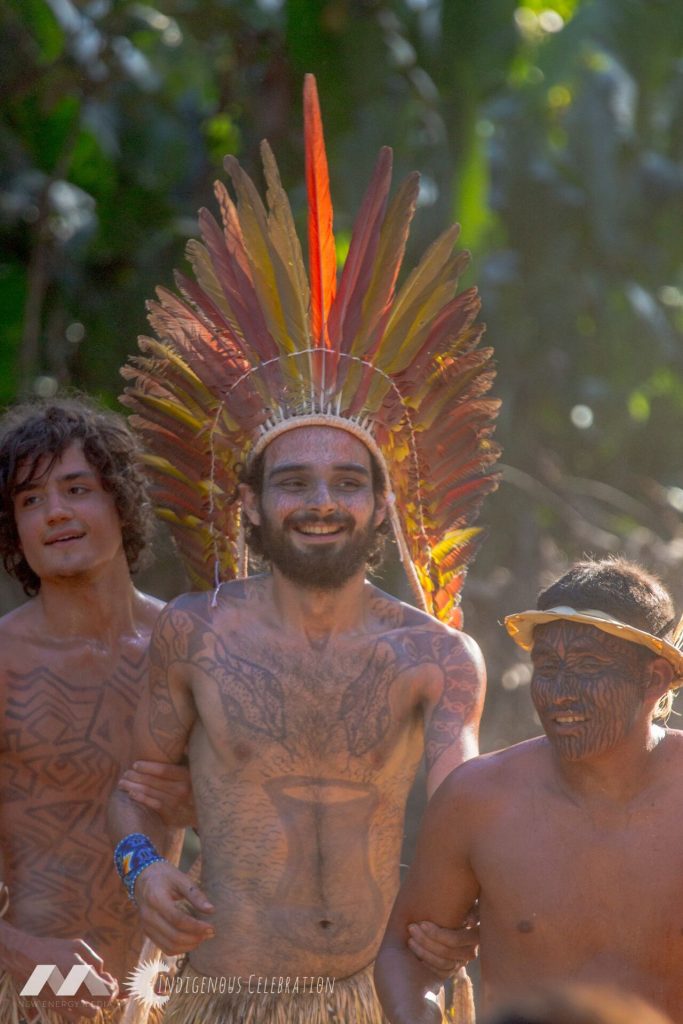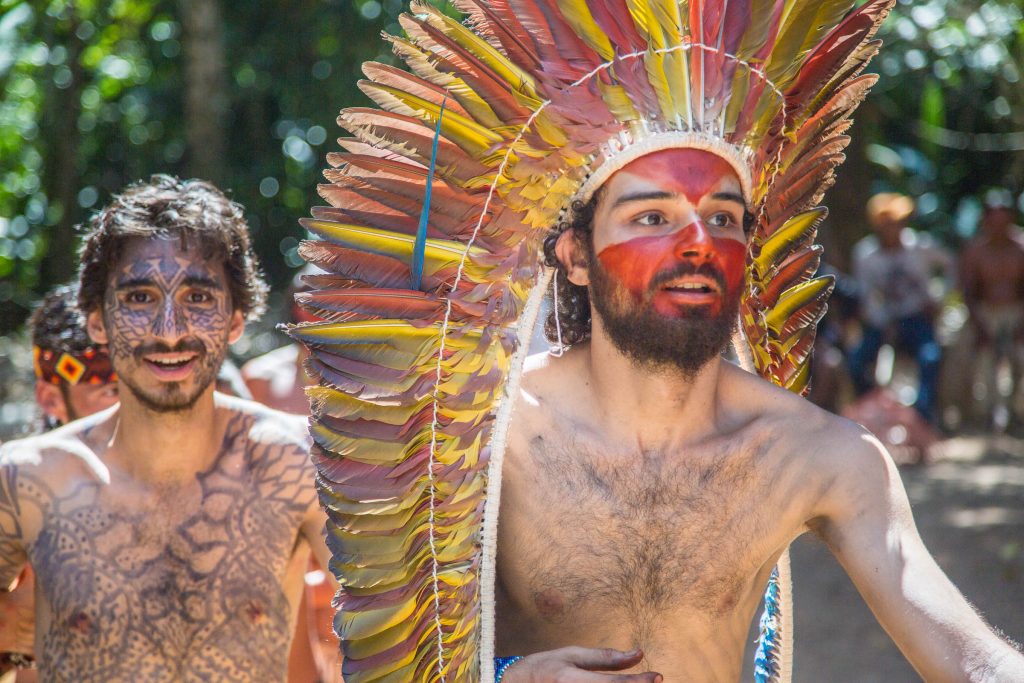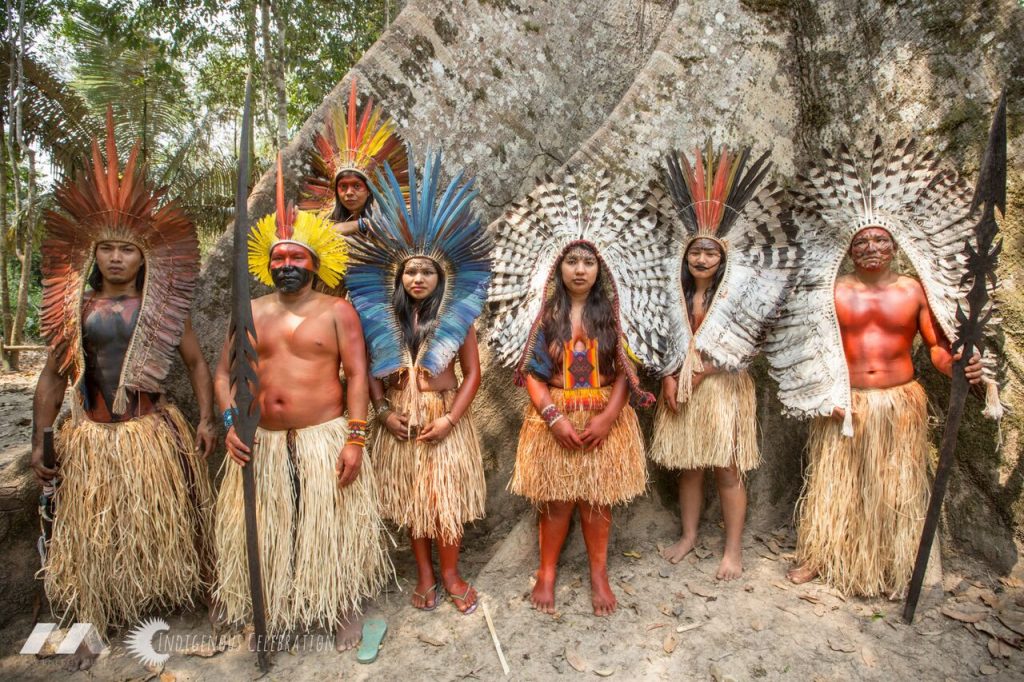

Be the first to know! Sign up to be notified of our next Trip to Mutum Village
A gorgeous 3-story tree house awaits!
Meals and group meetings are held on the first level.
The second level is used for lodging, where we string our hammocks. (Beds are also
available if needed).
The third level...? That's for taking in the sights of the tree-top canopy as you sip
your morning coffee!

The retreat will be led by Jordão Souza.
Jordão first made contact with the Yawanawá in 2009 when he began immersing himself with Yawanawá culture, art, and music, studying Yawanawá medicinal plant knowledge and spirituality with the tribe’s elders. Jordão was the last student initiated (in the year-long Muka Dieta), by Pajé Tata (before his passing in December 2016 at the age of 103). This year, Jordão and his partner Kenewma Yawanawá (the daughter of chief Naiweni) welcomed their first son, Mukaihu.
Hear about the profound impact the Yawanawá have had on his life, and the awakening force of Mutum Village.

Be the first to know! Sign up to be notified of our next Trip to Mutum Village
Get a glimpse of what Mutum may hold for you…
Hear from 3 Jungle Warriors about their transformational experiences and the lasting benefits our last retreat to Mutum Village (in November 2017) has had on their lives:
Includes the following:
1. Bus Charter: Travel to and from Cruzeiro do Sul & São Vicente
2. Canoe: Travel to and from São Vicente to the Village of Mutum
3. (3) Traditional Yawanawá Uni (ayahuasca) ceremonies and opportunities to receive medicines such as rapé (hay-PAY)
4. Food and Lodging: for 9 days in the Village of Mutum
5. IC Jungle Warrior's Goodie bag 🙂
*The Journey Package does not include flights, or private treatments with the Pajés and Nipei’hu, such as Kambô, medicinal leaf bath, or Yawanawá goods, such as beaded jewelry, curripis and other art crafts.
Be the first to know! Sign up to be notified of our next Trip to Mutum Village
 Yawanawá means “People of the Wild Boar,” and according to traditional stories, their history dates back 10,000 years, inhabiting in the same region of the Brazilian Amazon for millenia.
Yawanawá means “People of the Wild Boar,” and according to traditional stories, their history dates back 10,000 years, inhabiting in the same region of the Brazilian Amazon for millenia.
In the late 19th century, the first contact with western society was made. Rubber planters invaded, claimed to own the land, and enslaved the people. This initial contact introduced diseases the Yawanawá had no immunity to, in addition to alcohol, sugar, and salt - substances that caused diseases the Yawanawá Pajés were unfamiliar with and couldn’t cure. Nearly 90% of the population was lost and for generations, the Yawanawá have struggled to keep their identity and community intact. Today there are approximately 800 Yawanawá living in 8 Villages along the Rio Gregório.
Shortly after the rubber planters invaded, missionaires arrived.
Not knowing how to value the true wisdom and beauty of indigenous culture, the missionaires imposed their language, culture, and beliefs on the Yawanawá, forcing the spiritual elders to flee deep into the forest, to keep their precious cultural and spiritual lineage alive.
In 1984, 360 square miles (an area slightly larger than NYC) was demarcated as protected, indigenous territory. The Yawanawá were the first tribe in the region to go through this process. Soon, other indigenous leaders began working to demarcate their own territories. By 1991, the last of the missionaries were expelled from Yawanawá land, and a cultural and spiritual resurgence began. The elders returned to the community and started to hold the Mariri Traditional Festivals, but the path to recovering their ancestral ways remained long...
A dependence on a cash income developed within the last few generations, and several members left the community to seek work in cities and towns. Dependence on cash for gasoline to power canoes and generators, cash to treat western illnesses with western medicine, cash for supplemental food, like rice and beans (when the hunts were not enough). The indigenous are on the front lines of climate change, vulnerable to every disturbance in the ecosystem they’ve depended on for millennia. No longer able to hunt and fish during “usual” times, given the extreme weather patterns and an ever changing climate, they must travel to cities to purchase supplemental food for survival.
Yawanawá leaders like Tashka Yawanawá realized the tribe needed to develop ways to achieve economic independence so community members could return to the village and reestablish tribal traditions and culture.
Taking this Journey is an opportunity to help ensure this ancient wisdom is passed on to the next generation...
Funds from traveler’s Journey Package, help to fortify Yawanawá culture and spirituality.

Visiting Mutum Village has a profound and positive impact on the Yawanawá community, encouraging the new generation to learn from their elders, and giving value to a culture, that still lives in harmony with nature.
Support the continuation of Yawanawá language, culture, and spirituality.
Be the first to know! Sign up to be notified of our next Trip to Mutum Village
In 1996, after growing concerned about the continuation of Yawanawá ancient medicinal plant wisdom for future generations, Chief Tuîkuru dreamed of creating a central Nipei. Nipei is the Yawanawá name given to herbs and plants that cure diseases and physical illness. Medicinal plants are used to help women through childbirth, help children learn to walk and talk, and according to Chief Tuîkuru, the knowledge of medicinal plants is directly linked to Yawanawá survival.
Chief Tuîkuru understood the critical importance of passing on this ancient wisdom, and dedicated his life to this mission. He said that “Yawanawá education and spirituality are directly linked to knowledge about plants, for only knowing the plants, does one learn to respect, and deal, with the forest where we live.”
A four-hectare area of land in Mutum Village was demarcated for the Nipei: Garden of Medicines, where the few remaining elders work with their students to perform research, and healing treatments for tribe members and visitors. In November 2017, the Nipei: Garden of Medicines received its first patient.
The establishment of a dedicated Nipei, has helped the Yawanawá fully realize Chief Tuikuru’s dream and give continuation to this precious knowledge, by providing the space and opportunity for the Nipeihu to gather and put their vast medicinal plant knowledge into practice.
There are already many plants that have been forgotten, and each elder that passes is like losing an entire library of medicinal plant knowledge that cannot be found in books. According to estimates from experts in ethnobotany at the Smithsonian, about 95% of the plants used by the Yawanawá are not yet characterized in books.
Two Yawanawá elders, over the age of 100 years old, have passed within the last 18 months. It is with great urgency that we move to preserve a knowledge, a way of life, which is so critical to the future of human existence on this Earth.
Be part of preserving this ancient medicinal plant wisdom for generations to come.
Join us on the adventure of a lifetime and become part of the Yawanawá story during this critical moment in history.
Be the first to know! Sign up to be notified of our next Trip to Mutum Village